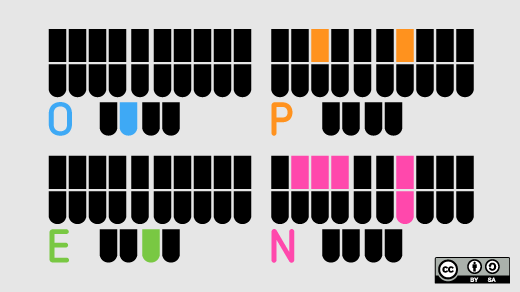"Imagine if programming required a special computer that couldn't connect to the internet or run games or do anything else except write computer software, and that it sold for $1,500. What do you think the state of software development would look like?"
I'm talking with Mirabai Knight, sole proprietor of StenoKnight CART Services, one of a small handful of providers of live captioning. I'm personally interested in this for a few reasons: first, I grew up with a severe hearing loss. However, like 98% of the 35 million deaf and hard of hearing people in the USA, I consider ASL (American Sign Language) a gorgeous language that I can't fluently understand. CART (Communication Access Realtime Transcription) offers an alternative option for folks like me; a stenographer sits either remotely or in the classroom, meeting, theatre, or wherever you are, and realtime captions stream to a projector screen, your laptop, your cellphone... it's like having closed-captioning for your life.
Second, I'm an open source geek, and Mirabai is describing the sort of locked-down proprietary domain that makes my blood boil. The equipment and software and training is so expensive that basically only people who intend to do it as a profession have any access to it; they buy $1,000 student hardware and $500 student software (professional software is $4,000) and then pay $300 or more per month to get dictated at by "readers" at for-profit schools geared towards the narrow domain of court transcriptions.
But it wasn't until Mirabai mentioned that she could get me to type 240 WPM on $45 of equipment that I really perked up. I'm a pretty fast typist, averaging 120-160 wpm on qwerty, but hand and shoulder troubles prevent me from going at it for more than an hour at a time, and even my flying fingers can't keep up with my racing thoughts. In contrast, Mirabai explained, steno is every bit as efficient as human speech and kinder on the hands, so it sounds like it should be the perfect thing for geeks. However, it's been forced into undeserved obscurity by its high entry cost and inaccessible design.
So last year, armed with a little free time, a few geek friends, and a Python programmer named Josh Lifton, she set out to change exactly that. The result is Plover, an open source stenography suite that works with a $45 gaming keyboard (not $1,000 hardware); the software is, of course, free. The Linux version is now complete, and a developer named Hesky Fisher has created a semi-functional Windows port that remains a work in progress; you can play around with an interactive online demo to get a basic idea of how steno would work with your keyboard, watch one of Mirabai's (captioned) talks on Plover, and check out the project wiki at https://ploversteno.org.
Plover isn't just a straight-out copy-paste of existing proprietary CART software; it also has several feature advantages over them. Most steno software has a time-based buffer, forcing the user to conform to the software's timing; Plover is designed the other way around, so the software responds to a human, and typists can take their time to think and control the pacing of their words. Plover is also the first steno software of any kind that follows the Unix design principle of modularity, acting essentially as a keyboard emulator - no different from any other alternative input option such as on-screen keyboards for tablets or input methods for the disabled. In contrast, proprietary steno programs contain full-fledged word processors that typists are then forced to use. "They have file managers, separate display and print settings for all text, and a whole host of other things that reinvent the wheel," Mirabai explained.
This complexity is frequently unnecessary. "My $4,000 steno machine malfunctioned at my afternoon class today. But for backup I always carry a qwerty keyboard that works with Plover, so I was still able to do my job. My court reporting software comes with a four-inch-thick manual that starts with "how to move the mouse"; goes through to automatic indexing, form filling, audio synchronization, and file management; and finishes with regular expressions. The software I used today to provide CART with Plover? [Open-source text editor] Gedit, with the font size increased to 28. The end."
Of course, stenography is difficult to learn, and the "just keep trying to type and you'll eventually get it" of professional steno schools seems... pedagogically suboptimal; typing up jury charges for three hours straight is enough to put anyone into a stupor. They're also expensive and have high dropout rates. "I don't want to be cynical," Mirabai told me, "but many of these for-profit schools make a tidy packet selling the $1,000 machine to all the incoming students, then buying it back for $300 when they drop out, and selling it again to another newbie."
That's why Mirabai is recruiting volunteer developers for Hover Plover, a series of arcade-style minigames for learning steno. She's thinking of a simple 2D platformer for one-stroke practice, a top-down space shooter for multi-stroke word and dictionary definition practice ("This might appeal to RPG lovers," Mirabai notes -- "building your own word hoard out of the spare parts floating around in your head"), and something like Guitar Hero for rhythm practice. "Most people in steno school get up to 100 WPM within the first six months or so. Then it takes them between two and six years to get the other 125 WPM, although I went from 0 to 255 WPM in a year and a half. But if someone's just using steno for RSI reasons or to increase the fluency of their writing or coding, 100 WPM is plenty fast for daily use; they can proceed and build speed naturally as they continue to use the software." Other developers have started making training tools as well; Pragma Nolint recently released Fly, a program that allows Plover users to do drill practice with their dictionaries.
I asked Mirabai what motivated her work on Plover. Her answer was so enthusiastic and eloquent that I've simply quoted it below in its entirety.
"Well, there are 547 registered ASL (American Sign Language) interpreters in New York State. (Ed. note: Mirabai did an interview on "That Keith Wann Show" on how CART and ASL are complementary rather than competitive.) As far as I can tell, there are fewer than 20 CART providers. Steno schools are shutting down. People are starting to consider it obsolete technology, because they're all holding out for natural language speech recognition, which has been "right around the corner" for the last 20 years. That's because they figure if people have been talking to computers on Star Trek since the '60s, it must already be a solved problem! The problem is that speech recognition, since it relies on matching waveforms probabilistically rather than semantically, is pretty much unable to cope with poor quality audio, nonstandard accents, homonyms, neologisms, mumbling, and a host of other common complications that crop up when transcribing speech in realtime."
"I know how useful steno is, not just for transcribing realtime speech, but for composing text at the speed of thought - and with fewer keystrokes than letter-for-letter typing systems, which makes steno more efficient, more portable, more ergonomic, more accurate, and faster than anything else out there. It's useful to FOSS geeks, accessibility mavens, video gamers, writers, and speed demons; my "What is Steno Good For" series goes into each of those in turn."
"Even if steno were only used to provide captioning for people with hearing loss (and central auditory processing disorder, autism, ADHD, kids learning how to read, speakers of language other than English who find it easier to comprehend by eye than by ear... The list goes on), we need many, many, many more people to do it. I also think that people with speech disabilities could be a potential power user base. It's the only input system that can let people speak at typical rates of speech just using their fingers. We've reached out to Roger Ebert, but he felt it was too much of an old dog new tricks situation. If you know of any people with speech disabilities who'd be willing to try it out, please let me know."
Mary Gardiner recently mentioned Plover in her PyConAu keynote, pointing out some of the things the fledgling project needs help with: testers to try out of the software, developers to work on feature implementation, cross-platform porting, and game development; visual and sound artists and game designers for Hover Plover... and help with making Plover a sustainable project, which may mean donations of time, equipment, money, or business model expertise. "I'm about tapped out of my own money," Mirabai explained. "I've put about $3,000 into it so far, and I don't think I have enough spare cash to bankroll the development of a whole game." We've since started looking for game development students who might be able to take on parts of Hover Plover as a class or capstone project.
"You're a great evangelist for this," I told her at the end of our interview.
"I'm just obsessed, is all," Mirabai responded. "I dream about it. Thanks so much for giving me a voice. Sometimes I tell people "I can type 240 words a minute" and they're like "Yeah, and? Who cares?" but sometimes people are like "Dude! That's so awesome! I wanna do that!" and that's when I think this thing actually has a chance."
For more on Mirabai and Plover, read her 2010 interview with Leigh Honeywell and check out the project website at https://ploversteno.org.







12 Comments